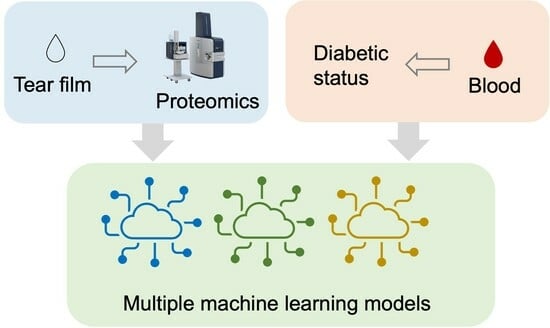Alterations in Tear Proteomes of Adults with Pre-Diabetes and Type 2 Diabetes Mellitus but Without Diabetic Retinopathy
Abstract
1. Introduction
2. Materials and Methods
2.1. Materials and Reagents
2.2. Subject Recruitment
2.3. Tear Collection
2.4. Clinical Assessments
2.5. Proteomic Sample Preparation
2.6. NanoLC-MS/MS
2.7. Data Processing
2.8. Data Analysis
3. Results
3.1. Subject Demographics and Clinical Characteristics
3.2. Proteomic Data
3.3. The Effect of Diabetic Status on Tear Proteome
4. Discussion
5. Conclusions
Supplementary Materials
Author Contributions
Funding
Institutional Review Board Statement
Informed Consent Statement
Data Availability Statement
Acknowledgments
Conflicts of Interest
Abbreviations
| T2DM | Type 2 Diabetes Mellitus |
| preDM | Pre-type 2 Diabetes Mellitus |
| diaPASEF | Data-Independent Acquisition Parallel Acquisition Serial Fragmentation |
| OSDI | Ocular Surface Disease Index |
| FA | Formic Acid |
| OCT | Ocular Coherence Tomographer |
| RF | Random Forest |
| SVM | Support Vector Machine |
References
- Sun, H.; Saeedi, P.; Karuranga, S.; Pinkepank, M.; Ogurtsova, K.; Duncan, B.B.; Stein, C.; Basit, A.; Chan, J.C.N.; Mbanya, J.C.; et al. IDF Diabetes Atlas: Global, regional and country-level diabetes prevalence estimates for 2021 and projections for 2045. Diabetes Res. Clin. Pract. 2022, 183, 13. [Google Scholar] [CrossRef]
- Richdale, K.; Chao, C.; Hamilton, M. Eye care providers’ emerging roles in early detection of diabetes and management of diabetic changes to the ocular surface: A review. Bmj Open Diabetes Res. Care 2020, 8, 9. [Google Scholar] [CrossRef] [PubMed]
- Chao, C.; Wang, R.; Jones, M.; Karson, N.; Jussel, A.; Smith, J.; Richdale, K.; Harrison, W. The Relationship Between Corneal Nerve Density and Hemoglobin A1c in Patients With Prediabetes and Type 2 Diabetes. Investig. Ophthalmol. Vis. Sci. 2020, 61, 8. [Google Scholar] [CrossRef] [PubMed]
- Nepp, J.; Abela, C.; Polzer, I.; Derbolav, A.; Wedrich, A. Is there a correlation between the severity of diabetic retinopathy and keratoconjunctivitis sicca? Cornea 2000, 19, 487–491. [Google Scholar] [CrossRef]
- Cheung, N.; Mitchell, P.; Wong, T.Y. Diabetic retinopathy. Lancet 2010, 376, 124–136. [Google Scholar] [CrossRef]
- Lauwen, S.; de Jong, E.K.; Lefeber, D.J.; den Hollander, A.I. Omics Biomarkers in Ophthalmology. Investig. Ophthalmol. Vis. Sci. 2017, 58, BIO88–BIO98. [Google Scholar] [CrossRef]
- Pusparajah, P.; Lee, L.H.; Kadir, K.A. Molecular Markers of Diabetic Retinopathy: Potential Screening Tool of the Future? Front. Physiol. 2016, 7, 19. [Google Scholar] [CrossRef]
- Zhan, X.Q.; Li, J.J.; Guo, Y.N.; Golubnitschaja, O. Mass spectrometry analysis of human tear fluid biomarkers specific for ocular and systemic diseases in the context of 3P medicine. Epma J. 2021, 12, 449–475. [Google Scholar] [CrossRef]
- Pang, Y.H.; Luo, C.K.; Zhang, Q.R.; Zhang, X.Z.; Liao, N.Y.; Ji, Y.Y.; Mi, L.; Gan, Y.H.; Su, Y.Y.; Wen, F.; et al. Multi-Omics Integration With Machine Learning Identified Early Diabetic Retinopathy, Diabetic Macula Edema and Anti-VEGF Treatment Response. Transl. Vis. Sci. Technol. 2024, 13, 13. [Google Scholar] [CrossRef]
- Curovic, V.R.; Suvitaival, T.; Mattila, I.; Ahonen, L.; Trost, K.; Theilade, S.; Hansen, T.W.; Legido-Quigley, C.; Rossing, P. Circulating Metabolites and Lipids Are Associated to Diabetic Retinopathy in Individuals With Type 1 Diabetes. Diabetes 2020, 69, 2217–2226. [Google Scholar] [CrossRef]
- Patrick, A.T.; He, W.L.; Madu, J.; Sripathi, S.R.; Choi, S.; Lee, K.; Samson, F.P.; Powell, F.L.; Bartoli, M.; Jee, D.; et al. Mechanistic dissection of diabetic retinopathy using the protein-metabolite interactome. J. Diabetes Metab. Disord. 2020, 19, 829–848. [Google Scholar] [CrossRef] [PubMed]
- Csosz, E.; Deak, E.; Kallo, G.; Csutak, A.; Tozser, J. Diabetic retinopathy: Proteomic approaches to help the differential diagnosis and to understand the underlying molecular mechanisms. J. Proteom. 2017, 150, 351–358. [Google Scholar] [CrossRef] [PubMed]
- Cryan, L.M.; O’Brien, C. Proteomics as a research tool in clinical and experimental ophthalmology. Proteom. Clin. Appl. 2008, 2, 762–775. [Google Scholar] [CrossRef] [PubMed]
- Youngblood, H.; Robinson, R.; Sharma, A.; Sharma, S. Proteomic Biomarkers of Retinal Inflammation in Diabetic Retinopathy. Int. J. Mol. Sci. 2019, 20, 4755. [Google Scholar] [CrossRef]
- Monteiro, J.P.; Santos, F.M.; Rocha, A.S.; Castro-de-Sousa, J.P.; Queiroz, J.A.; Passarinha, L.A.; Tomaz, C.T. Vitreous humor in the pathologic scope: Insights from proteomic approaches. Proteom. Clin. Appl. 2015, 9, 187–202. [Google Scholar] [CrossRef]
- Wang, H.; Feng, L.; Hu, J.W.; Xie, C.L.; Wang, F. Characterisation of the vitreous proteome in proliferative diabetic retinopathy. Proteome Sci. 2012, 10, 11. [Google Scholar] [CrossRef]
- Walia, S.; Clermont, A.C.; Gao, B.B.; Aiello, L.P.; Feener, E.P. Vitreous Proteomics and Diabetic Retinopathy. Semin. Ophthalmol. 2010, 25, 289–294. [Google Scholar] [CrossRef]
- Ponzini, E.; Santambrogio, C.; De Palma, A.; Mauri, P.; Tavazzi, S.; Grandori, R. Mass spectrometry-based tear proteomics for noninvasive biomarker discovery. Mass Spectrom. Rev. 2021, 41, 842–860. [Google Scholar] [CrossRef]
- Zhou, L.; Beuerman, R.W. The power of tears: How tear proteomics research could revolutionize the clinic. Expert Rev. Proteom. 2017, 14, 189–191. [Google Scholar] [CrossRef]
- Zhou, L.; Beuerman, R.W. Tear analysis in ocular surface diseases. Prog. Retin. Eye Res. 2012, 31, 527–550. [Google Scholar] [CrossRef]
- Hohenstein-Blaul, N.V.U.; Funke, S.; Grus, F.H. Tears as a source of biomarkers for ocular and systemic diseases. Exp. Eye Res. 2013, 117, 126–137. [Google Scholar] [CrossRef] [PubMed]
- Tong, L.; Zhou, L.; Beuerman, R.W.; Zhao, S.Z.; Li, X.R. Association of tear proteins with Meibomian gland disease and dry eye symptoms. Br. J. Ophthalmol. 2011, 95, 848–852. [Google Scholar] [CrossRef] [PubMed]
- Winiarczyk, M.; Winiarczyk, D.; Michalak, K.; Kaarniranta, K.; Adaszek, L.; Winiarczyk, S.; Mackiewicz, J. Dysregulated Tear Film Proteins in Macular Edema Due to the Neovascular Age-Related Macular Degeneration Are Involved in the Regulation of Protein Clearance, Inflammation, and Neovascularization. J. Clin. Med. 2021, 10, 3060. [Google Scholar] [CrossRef] [PubMed]
- Chen, X.L.; Rao, J.; Zheng, Z.; Yu, Y.; Lou, S.; Liu, L.P.; He, Q.S.; Wu, L.H.; Sun, X.H. Integrated Tear Proteome and Metabolome Reveal Panels of Inflammatory-Related Molecules via Key Regulatory Pathways in Dry Eye Syndrome. J. Proteome Res. 2019, 18, 2321–2330. [Google Scholar] [CrossRef]
- Perumal, N.; Funke, S.; Pfeiffer, N.; Grus, F.H. Proteomics analysis of human tears from aqueous-deficient and evaporative dry eye patients. Sci. Rep. 2016, 6, 29629. [Google Scholar] [CrossRef]
- Pieragostino, D.; Agnifili, L.; Fasanella, V.; D’Aguanno, S.; Mastropasqua, R.; Di Ilio, C.; Sacchetta, P.; Urbani, A.; Del Boccio, P. Shotgun proteomics reveals specific modulated protein patterns in tears of patients with primary open angle glaucoma naive to therapy. Mol. Biosyst. 2013, 9, 1108–1116. [Google Scholar] [CrossRef]
- Versura, P.; Nanni, P.; Bavelloni, A.; Blalock, W.L.; Piazzi, M.; Roda, A.; Campos, E.C. Tear proteomics in evaporative dry eye disease. Eye 2010, 24, 1396–1402. [Google Scholar] [CrossRef]
- Lopez-Lopez, M.; Regueiro, U.; Bravo, S.B.; Chantada-Vazquez, M.D.; Varela-Fernandez, R.; Avila-Gomez, P.; Hervella, P.; Lema, I. Tear Proteomics in Keratoconus: A Quantitative SWATH-MS Analysis. Investig. Ophthalmol. Vis. Sci. 2021, 62, 30. [Google Scholar] [CrossRef]
- Torok, Z.; Peto, T.; Csosz, E.; Tukacs, E.; Molnar, A.; Maros-Szabo, Z.; Berta, A.; Tozser, J.; Hajdu, A.; Nagy, V.; et al. Tear fluid proteomics multimarkers for diabetic retinopathy screening. BMC Ophthalmol. 2013, 13, 40. [Google Scholar] [CrossRef]
- Li, B.; Sheng, M.J.; Xie, L.Q.; Liu, F.; Yan, G.Q.; Wang, W.F.; Lin, A.J.; Zhao, F.; Chen, Y.H. Tear Proteomic Analysis of Patients With Type 2 Diabetes and Dry Eye Syndrome by Two-Dimensional Nano-Liquid Chromatography Coupled With Tandem Mass Spectrometry. Investig. Ophthalmol. Vis. Sci. 2014, 55, 177–186. [Google Scholar] [CrossRef]
- Csosz, E.; Boross, P.; Csutak, A.; Berta, A.; Toth, F.; Poliska, S.; Torok, Z.; Tozser, J. Quantitative analysis of proteins in the tear fluid of patients with diabetic retinopathy. J. Proteom. 2012, 75, 2196–2204. [Google Scholar] [CrossRef] [PubMed]
- Kim, H.J.; Kim, P.K.; Yoo, H.S.; Kim, C.W. Comparison of tear proteins between healthy and early diabetic retinopathy patients. Clin. Biochem. 2012, 45, 60–67. [Google Scholar] [CrossRef] [PubMed]
- Zagst, A.J.; Smith, J.D.; Wang, R.; Harrison, W.W. Foveal avascular zone size and mfERG metrics in diabetes and prediabetes: A pilot study of the relationship between structure and function. Doc. Ophthalmol. 2023, 147, 99–107. [Google Scholar] [CrossRef] [PubMed]
- Schiffman, R.M.; Christianson, M.D.; Jacobsen, G.; Hirsch, J.D.; Reis, B.L. Reliability and validity of the ocular surface disease index. Arch. Ophthalmol. 2000, 118, 615–621. [Google Scholar] [CrossRef]
- Qin, G.; Chao, C.; Lattery, L.J.; Lin, H.; Fu, W.; Richdale, K.; Cai, C. Tear proteomic analysis of young glasses, orthokeratology, and soft contact lens wearers. J. Proteom. 2023, 270, 104738. [Google Scholar] [CrossRef]
- Meier, F.; Brunner, A.D.; Frank, M.; Ha, A.; Bludau, I.; Voytik, E.; Kaspar-Schoenefeld, S.; Lubeck, M.; Raether, O.; Bache, N.; et al. diaPASEF: Parallel accumulation-serial fragmentation combined with data-independent acquisition. Nat. Methods 2020, 17, 1229–1236. [Google Scholar] [CrossRef]
- Meier, F.; Brunner, A.D.; Frank, M.; Ha, A.; Voytik, E.; Kaspar-Schoenefeld, S.; Lubeck, M.; Raether, O.; Aebersold, R.; Collins, B.C.; et al. Parallel accumulation—Serial fragmentation combined with data-independent acquisition (diaPASEF). Mol. Cell Proteom. 2019, 18, S17. [Google Scholar] [CrossRef]
- Qin, G.; Zhang, P.; Sun, M.; Fu, W.; Cai, C. Comprehensive spectral libraries for various rabbit eye tissue proteomes. Sci. Data 2022, 9, 111. [Google Scholar] [CrossRef]
- Breiman, L. Random Forests. Mach. Learn. 2001, 45, 5–32. [Google Scholar] [CrossRef]
- Cortes, C.; Vapnik, V.N. Support-vector networks. Mach. Learn. 2004, 20, 273–297. [Google Scholar]
- Tibshirani, R. Regression Shrinkage and Selection via the Lasso. J. R. Stat. Soc. Ser. B Methodol. 1996, 58, 267–288. [Google Scholar] [CrossRef]
- Fan, J.Q.; Lv, J.C. Sure independence screening for ultrahigh dimensional feature space. J. R. Stat. Soc. Ser. B-Stat. Methodol. 2008, 70, 849–883. [Google Scholar] [CrossRef] [PubMed]
- Mi, H.Y.; Ebert, D.; Muruganujan, A.; Mills, C.; Albou, L.P.; Mushayamaha, T.; Thomas, P.D. PANTHER version 16: A revised family classification, tree-based classification tool, enhancer regions and extensive API. Nucleic Acids Res. 2021, 49, D394–D403. [Google Scholar] [CrossRef] [PubMed]
- Mi, H.Y.; Muruganujan, A.; Huang, X.S.; Ebert, D.; Mills, C.; Guo, X.Y.; Thomas, P.D. Protocol Update for large-scale genome and gene function analysis with the PANTHER classification system (v.14.0). Nat. Protoc. 2019, 14, 703–721. [Google Scholar] [CrossRef]
- Ritchie, M.E.; Phipson, B.; Wu, D.; Hu, Y.; Law, C.W.; Shi, W.; Smyth, G.K. limma powers differential expression analyses for RNA-sequencing and microarray studies. Nucleic Acids Res. 2015, 43, e47. [Google Scholar] [CrossRef]
- Schwammle, V.; Leon, I.R.; Jensen, O.N. Assessment and Improvement of Statistical Tools for Comparative Proteomics Analysis of Sparse Data Sets with Few Experimental Replicates. J. Proteome Res. 2013, 12, 3874–3883. [Google Scholar] [CrossRef]
- Aickin, M.; Gensler, H. Adjusting for multiple testing when reporting research results: The Bonferroni vs Holm methods. Am. J. Public Health 1996, 86, 726–728. [Google Scholar] [CrossRef]
- Bindea, G.; Mlecnik, B.; Hackl, H.; Charoentong, P.; Tosolini, M.; Kirilovsky, A.; Fridman, W.H.; Pages, F.; Trajanoski, Z.; Galon, J. ClueGO: A Cytoscape plug-in to decipher functionally grouped gene ontology and pathway annotation networks. Bioinformatics 2009, 25, 1091–1093. [Google Scholar] [CrossRef]
- Shannon, P.; Markiel, A.; Ozier, O.; Baliga, N.S.; Wang, J.T.; Ramage, D.; Amin, N.; Schwikowski, B.; Ideker, T. Cytoscape: A software environment for integrated models of biomolecular interaction networks. Genome Res. 2003, 13, 2498–2504. [Google Scholar] [CrossRef]
- Nattinen, J.; Jylha, A.; Aapola, U.; Makinen, P.; Beuerman, R.; Pietila, J.; Vaajanen, A.; Uusitalo, H. Age-associated changes in human tear proteome. Clin. Proteom. 2019, 16, 11. [Google Scholar] [CrossRef]
- Rajkomar, A.; Dean, J.; Kohane, I. Machine Learning in Medicine. N. Engl. J. Med. 2019, 380, 1347–1358. [Google Scholar] [CrossRef]
- Ray, A. Machine learning in postgenomic biology and personalized medicine. Wiley Interdiscip. Rev.-Data Min. Knowl. Discov. 2022, 12, e1451. [Google Scholar] [CrossRef] [PubMed]
- Yu, W.; Liu, T.B.; Valdez, R.; Gwinn, M.; Khoury, M.J. Application of support vector machine modeling for prediction of common diseases: The case of diabetes and pre-diabetes. Bmc Med. Inform. Decis. Mak. 2010, 10, 16. [Google Scholar] [CrossRef] [PubMed]
- Li, J.; Riau, A.K.; Setiawan, M.; Mehta, J.S.; Ti, S.E.; Tong, L.; Tan, D.T.H.; Beuerman, R.W. S100A expression in normal corneal-limbal epithelial cells and ocular surface squamous cell carcinoma tissue. Mol. Vis. 2011, 17, 2263–2271. [Google Scholar] [PubMed]
- Wu, Y.; Wu, S.B.; Li, F.; Zeng, T.; Luo, X.H. Association between serum S100A11 levels and glucose metabolism in diabetic process. Diabetol. Metab. Syndr. 2023, 15, 36. [Google Scholar] [CrossRef]
- Wu, M.; Zhang, Y. Combining bioinformatics, network pharmacology and artificial intelligence to predict the mechanism of celastrol in the treatment of type 2 diabetes. Front. Endocrinol. 2022, 13, 1030278. [Google Scholar] [CrossRef]
- Benitez-del-Castillo, J.M.; Soria, J.; Acera, A.; Munoz, A.M.; Rodriguez, S.; Suarez, T. Quantification of a panel for dry-eye protein biomarkers in tears: A comparative pilot study using standard ELISA and customized microarrays. Mol. Vis. 2021, 27, 243–261. [Google Scholar]
- Soria, J.; Acera, A.; Merayo-Lloves, J.; Duran, J.A.; Gonzalez, N.; Rodriguez, S.; Bistolas, N.; Schumacher, S.; Bier, F.F.; Peter, H.; et al. Tear proteome analysis in ocular surface diseases using label-free LC-MS/MS and multiplexed-microarray biomarker validation. Sci. Rep. 2017, 7, 17478. [Google Scholar] [CrossRef]
- Border, M.B.; Schwartz, S.; Carlson, J.; Dibble, C.F.; Kohltfarber, H.; Offenbacher, S.; Buse, J.B.; Bencharit, S. Exploring salivary proteomes in edentulous patients with type 2 diabetes. Mol. Biosyst. 2012, 8, 1304–1310. [Google Scholar] [CrossRef]
- Luo, X.Y.; Dai, W.; Chee, M.L.; Tao, Y.J.; Chua, J.; Tan, N.Y.Q.; Tham, Y.C.; Aung, T.; Wong, T.Y.; Cheng, C.Y. Association of Diabetes With Central Corneal Thickness Among a Multiethnic Asian Population. Jama Netw. Open 2019, 2, e186647. [Google Scholar] [CrossRef]
- Busted, N.; Olsen, T.; Schmitz, O. Clinical observations on the corneal thickness and the corneal endothelium in diabetes-mellitus. Br. J. Ophthalmol. 1981, 65, 687–690. [Google Scholar] [CrossRef] [PubMed]
- Lee, J.S.; Oum, B.S.; Choi, H.Y.; Lee, J.E.; Cho, B.M. Differences in corneal thickness and corneal endothelium related to duration in Diabetes. Eye 2006, 20, 315–318. [Google Scholar] [CrossRef] [PubMed]
- Ozdamar, Y.; Cankaya, B.; Ozalp, S.; Acaroglu, G.; Karakaya, J.; Özkan, S.S. Is There a Correlation Between Diabetes Mellitus and Central Corneal Thickness? J. Glaucoma 2010, 19, 613–616. [Google Scholar] [CrossRef] [PubMed]
- Inoue, K.; Kato, S.; Inoue, Y.; Amano, S.; Oshika, T. The corneal endothelium and thickness in type II diabetes mellitus. Jpn. J. Ophthalmol. 2002, 46, 65–69. [Google Scholar] [CrossRef]
- Cheung, J.K.W.; Bian, J.F.; Sze, Y.H.; So, Y.K.; Chow, W.Y.; Woo, C.; Wong, M.T.K.; Li, K.K.; Lam, T.C. Human tear proteome dataset in response to daily wear of water gradient contact lens using SWATH-MS approach. Data Brief 2021, 36, 107120. [Google Scholar] [CrossRef]
- Zhou, L.; Beuerman, R.W.; Chan, C.M.; Zhao, S.Z.; Li, X.R.; Yang, H.; Tong, L.; Liu, S.P.; Stern, M.E.; Tan, D. Identification of Tear Fluid Biomarkers in Dry Eye Syndrome Using iTRAQ Quantitative Proteomics. J. Proteome Res. 2009, 8, 4889–4905. [Google Scholar] [CrossRef]
- Willcox, M.D.P. Tear film, contact lenses and tear biomarkers. Clin. Exp. Optom. 2019, 102, 350–363. [Google Scholar] [CrossRef]
- You, J.J.; Fitzgerald, A.; Cozzi, P.J.; Zhao, Z.; Graham, P.; Russell, P.J.; Walsh, B.J.; Willcox, M.; Zhong, L.; Wasinger, V.; et al. Post-translation modification of proteins in tears. Electrophoresis 2010, 31, 1853–1861. [Google Scholar] [CrossRef]
- Huang, Z.; Du, C.X.; Pan, X.D. The use of in-strip digestion for fast proteomic analysis on tear fluid from dry eye patients. PLoS ONE 2018, 13, e0200702. [Google Scholar] [CrossRef]
- Chen, B.J.; Lam, T.C.; Liu, L.Q.; To, C.H. Post-translational modifications and their applications in eye research. Mol. Med. Rep. 2017, 15, 3923–3935. [Google Scholar] [CrossRef]
- Qin, G.T.; Duong, S.; Fu, Y.X.; Cai, C.Z. A Highly Efficient Click Linker for Enrichment of Alkyne-Tagged Proteins in Living Cells. Helv. Chim. Acta 2024, 107, e202400031. [Google Scholar] [CrossRef]
- Deutsch, E.W.; Bandeira, N.; Sharma, V.; Perez-Riverol, Y.; Carver, J.J.; Kundu, D.J.; Garcia-Seisdedos, D.; Jarnuczak, A.F.; Hewapathirana, S.; Pullman, B.S.; et al. The ProteomeXchange consortium in 2020: Enabling ‘big data’ approaches in proteomics. Nucleic Acids Res. 2020, 48, D1145–D1152. [Google Scholar] [CrossRef] [PubMed]
- Perez-Riverol, Y.; Csordas, A.; Bai, J.W.; Bernal-Llinares, M.; Hewapathirana, S.; Kundu, D.J.; Inuganti, A.; Griss, J.; Mayer, G.; Eisenacher, M.; et al. The PRIDE database and related tools and resources in 2019: Improving support for quantification data. Nucleic Acids Res. 2019, 47, D442–D450. [Google Scholar] [CrossRef] [PubMed]
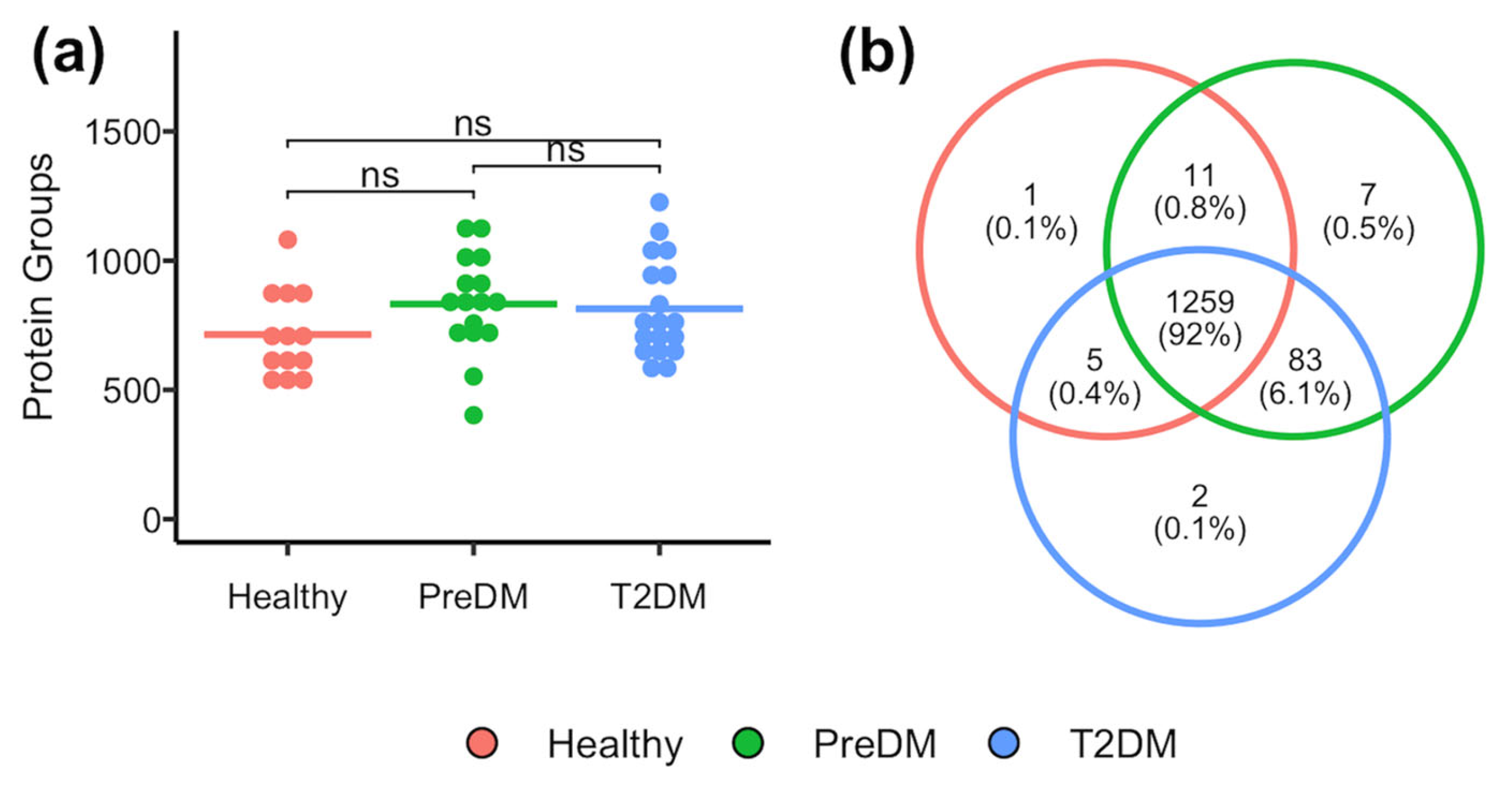
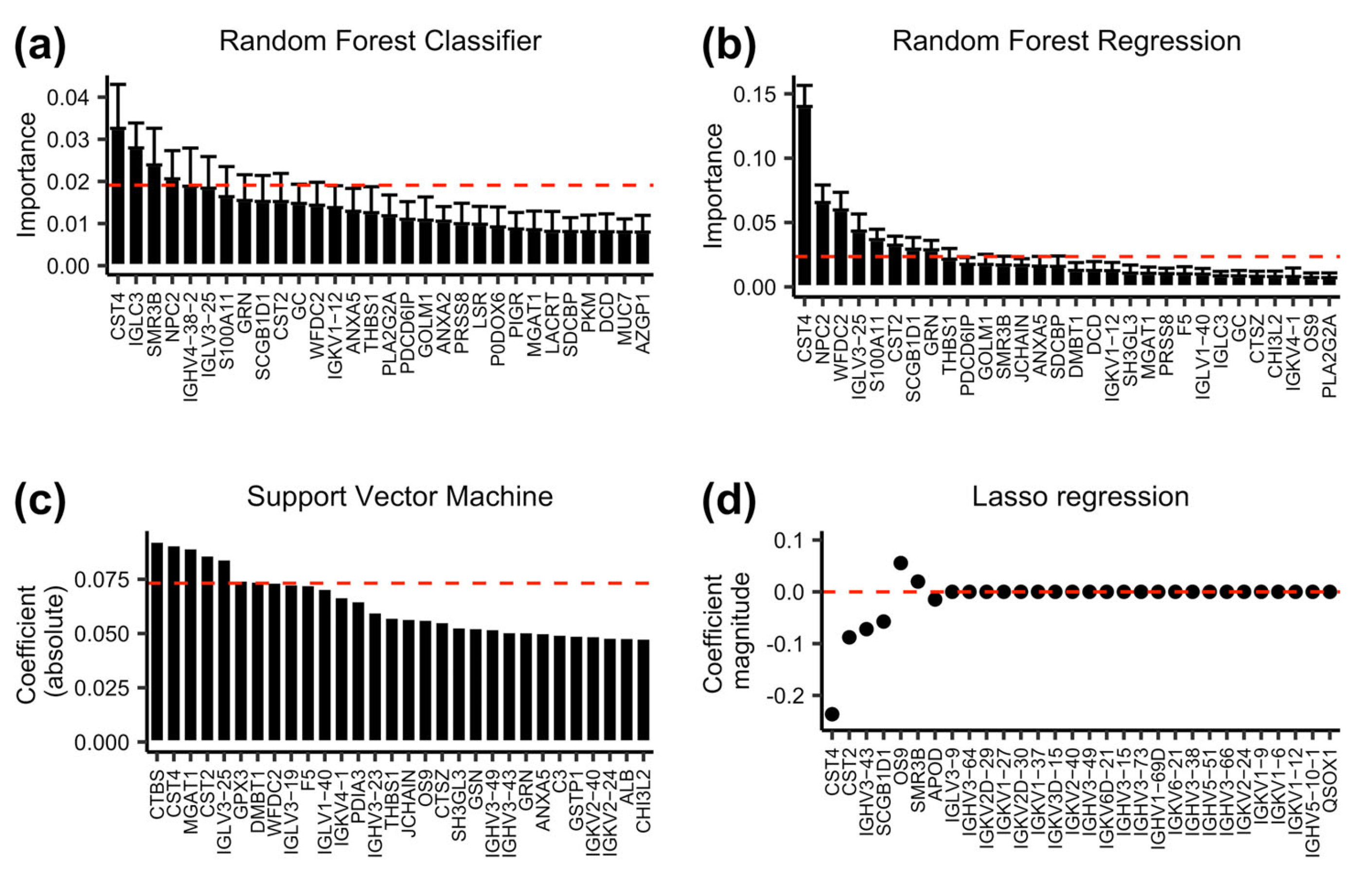
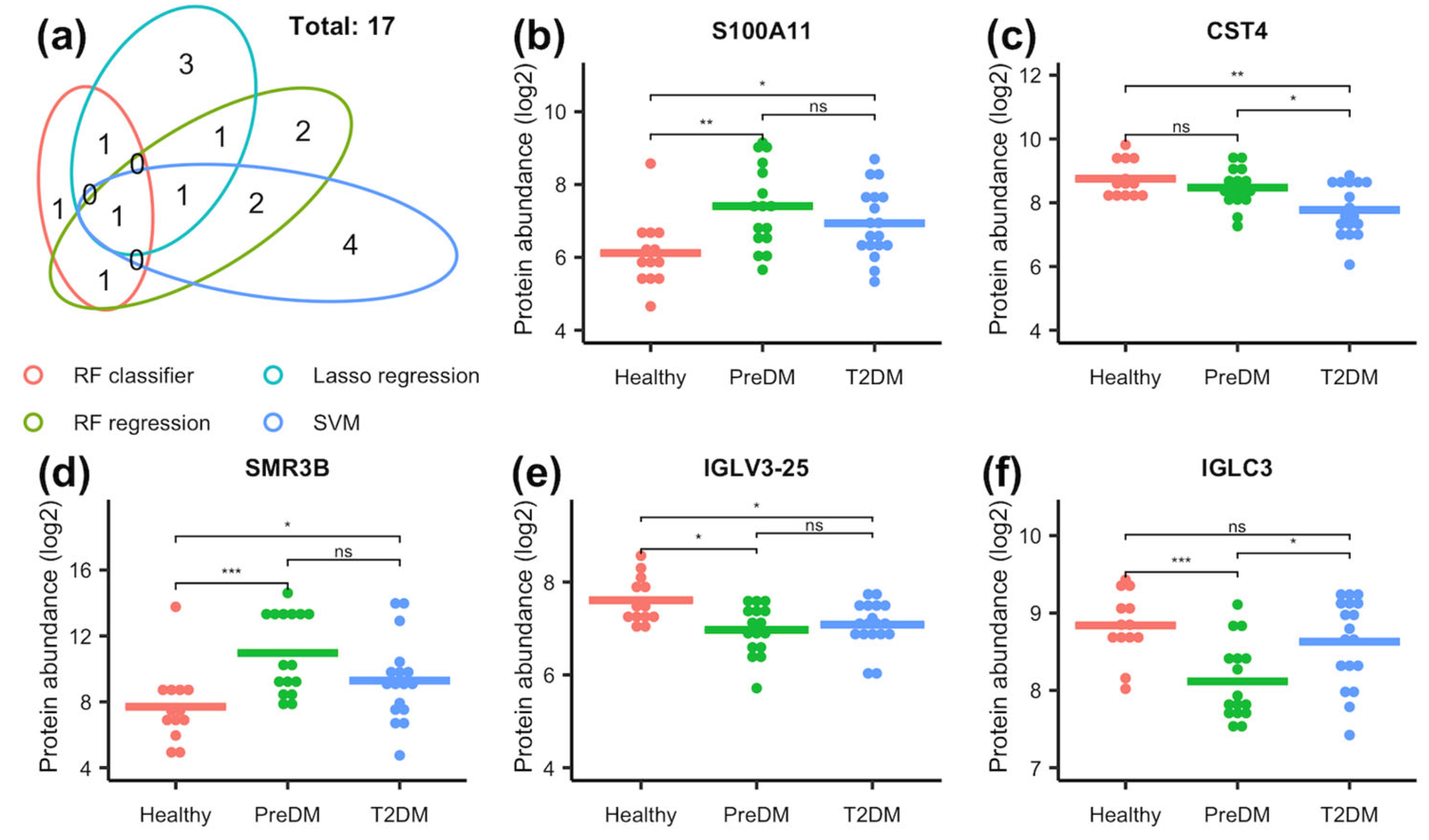


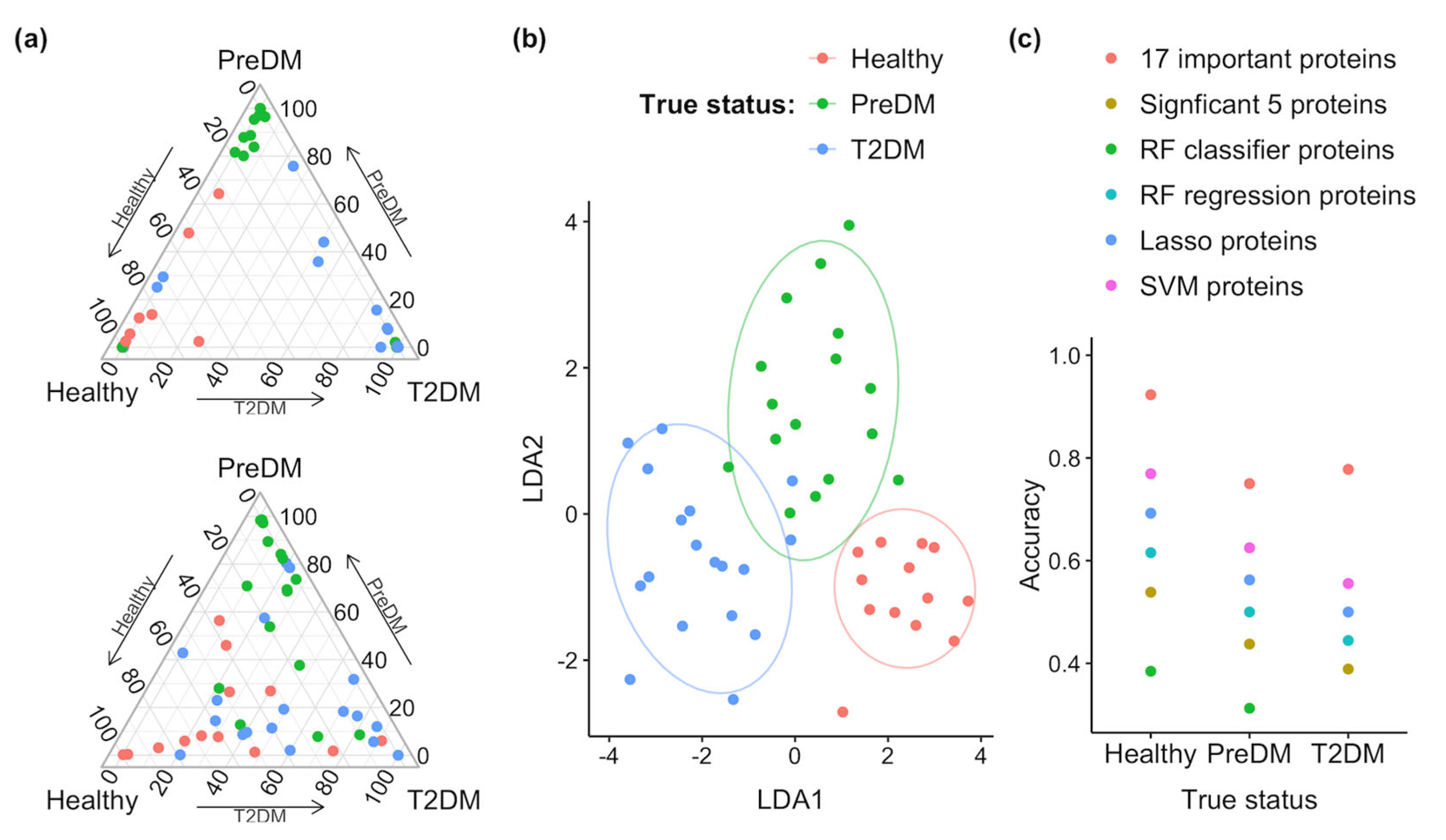
| Healthy Control (n = 13) | PreDM (n = 16) | T2DM (n = 18) | p Value | |
|---|---|---|---|---|
| Hemoglobin A1c (%) | 5.3 (5.1–5.4) | 5.8 (5.8–5.9) | 7.1 (6.7–7.8) | <0.001 |
| Sex (Female/Male) | 9/4 | 14/2 | 12/6 | 0.33 |
| Age (years) | 46 (42–52) | 59 (50–66) | 58 (54–59) | 0.02 |
| OSDI score (0–100) | 12.5 (2.5–18.8) | 7.5 (6.3–15.1) | 13.6 (5.5–21.3) | 0.57 |
| CLW (Yes/No) | 4/9 | 0/16 | 4/14 | 0.06 |
| Central corneal thickness (OS) | 533 (523–559) | 522 (500–544) | 534 (506–568) | 0.53 |
| Peripheral corneal thickness (OS) | 687 (671–726) | 675 (663–699) | 704 (671–748) | 0.33 |
| UniProt ID | Gene | Description | Protein Class |
|---|---|---|---|
| A0A0B4J1X8 | IGHV3-43 | Immunoglobulin heavy variable 3-43 | calcium-binding protein |
| O95968 | SCGB1D1 | Secretoglobin family 1D member 1 | defense/immunity protein |
| P01036 | CST4 | Cystatin-S | defense/immunity protein |
| P01717 | IGLV3-25 | Immunoglobulin lambda variable 3-25 | defense/immunity protein |
| P02814 | SMR3B | Submaxillary gland androgen-regulated protein 3B | defense/immunity protein |
| P05090 | APOD | Apolipoprotein D | protein-binding activity modulator |
| P09228 | CST2 | Cystatin-SA | protein-binding activity modulator |
| P0DOY3 | IGLC3 | Immunoglobulin lambda constant 3 | protein-binding activity modulator |
| P22352 | GPX3 | Glutathione peroxidase 3 | transfer/carrier protein |
| P26572 | MGAT1 | Alpha-1,3-mannosyl-glycoprotein 2-beta-N-acetylglucosaminyltransferase | transfer/carrier protein |
| P28799 | GRN | Progranulin | protein-modifying enzyme |
| P31949 | S100A11 | Protein S100-A11 | metabolite interconversion enzyme |
| P61916 | NPC2 | NPC intracellular cholesterol transporter 2 | Unclassified |
| Q01459 | CTBS | Di-N-acetylchitobiase | Unclassified |
| Q13438 | OS9 | Protein OS-9 | Unclassified |
| Q14508 | WFDC2 | WAP four-disulfide core domain protein 2 | Unclassified |
| Q9UGM3 | DMBT1 | Deleted in malignant brain tumors 1 protein | protein-modifying enzyme |
Disclaimer/Publisher’s Note: The statements, opinions and data contained in all publications are solely those of the individual author(s) and contributor(s) and not of MDPI and/or the editor(s). MDPI and/or the editor(s) disclaim responsibility for any injury to people or property resulting from any ideas, methods, instructions or products referred to in the content. |
© 2025 by the authors. Licensee MDPI, Basel, Switzerland. This article is an open access article distributed under the terms and conditions of the Creative Commons Attribution (CC BY) license (https://creativecommons.org/licenses/by/4.0/).
Share and Cite
Qin, G.; Chao, C.; Duong, S.; Smith, J.; Lin, H.; Harrison, W.W.; Cai, C. Alterations in Tear Proteomes of Adults with Pre-Diabetes and Type 2 Diabetes Mellitus but Without Diabetic Retinopathy. Proteomes 2025, 13, 29. https://doi.org/10.3390/proteomes13030029
Qin G, Chao C, Duong S, Smith J, Lin H, Harrison WW, Cai C. Alterations in Tear Proteomes of Adults with Pre-Diabetes and Type 2 Diabetes Mellitus but Without Diabetic Retinopathy. Proteomes. 2025; 13(3):29. https://doi.org/10.3390/proteomes13030029
Chicago/Turabian StyleQin, Guoting, Cecilia Chao, Shara Duong, Jennyffer Smith, Hong Lin, Wendy W. Harrison, and Chengzhi Cai. 2025. "Alterations in Tear Proteomes of Adults with Pre-Diabetes and Type 2 Diabetes Mellitus but Without Diabetic Retinopathy" Proteomes 13, no. 3: 29. https://doi.org/10.3390/proteomes13030029
APA StyleQin, G., Chao, C., Duong, S., Smith, J., Lin, H., Harrison, W. W., & Cai, C. (2025). Alterations in Tear Proteomes of Adults with Pre-Diabetes and Type 2 Diabetes Mellitus but Without Diabetic Retinopathy. Proteomes, 13(3), 29. https://doi.org/10.3390/proteomes13030029




